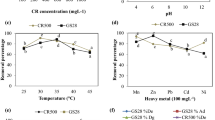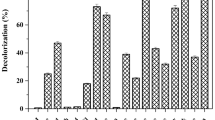Abstract
A novel approach had been carried out to develop fungal consortium, namely, RH-2, containing two marine procured fungal isolates in order to evaluate biodegradation of recalcitrant diazo dye Congo red. The fungi were isolated from the seacoast of Diu, India. According to the ITS sequencing, the strains were identified as Penicillium oxalicum (DS-2) and Aspergillus tubingensis (DS-4). Discs of 12 mm were cut out from the edge of both the fungal isolates (DS-2 and DS-4) and inoculated in flasks consisting of potato dextrose broth with 100 mg/L Congo red for the development of fungal consortium RH-2. The degradation by the fungal consortium RH-2 was more effective than the fungal monocultures DS-2 and DS-4 with the respective degradation reaching 97.15 ± 0.15%, 68.96 ± 0.09%, and 29.96 ± 0.21% in addition of yeast extract (1% w/v) within 12 h. The influence of dextrose (1% w/v), yeast extract (1% w/v), pH 5, and salt concentration (1% w/v) enhanced the degradation potential of fungal consortium RH-2. The maximal degradation was correlated with the production of laccase (12.498 ± 0.21 U/mL) and manganese peroxidase (10.314 ± 0.25 U/mL). The catabolism of Congo red was confirmed by UV–Visible spectroscopic analysis (Congo red λ-max = 499 nm) and ATR-FTIR spectroscopic analysis. The filtrates obtained after Congo red degradation were also evaluated for microbial toxicity against bacteria (Bacillus haynesii) and phytotoxicity analysis on plant seed (Trigonella foenum) which revealed that the filtrate acquired after the treatment of Congo red by fungal consortium RH-2 was less toxic than the original dye in nature. A novel aspect is determined by the evidence of mutualistic interaction between two different fungi for the rapid decolorization and degradation of dye providing a prospective of utilizing the developed consortium RH-2 as a cost-effective approach in textile wastewater treatment for cleaner environment.
Graphical abstract






Similar content being viewed by others
References
Abd El-Rahim WM, Moawad H, Abdel Azeiz AZ, Sadowsky MJ (2017) Optimization of conditions for decolorization of azo-based textile dyes by multiple fungal species. J Biotechnol 260:11–17. https://doi.org/10.1016/j.jbiotec.2017.08.022
Allen RLM (1971) The chemistry of azo dyes. Colour Chemistry Studies in Modern Chemistry. Springer, Boston, MA, pp 21–36
Asgher M, Bhatti HN, Ashraf M, Legge RL (2008) Recent developments in biodegradation of industrial pollutants by white rot fungi and their enzyme system. Biodegradation 19:771–783. https://doi.org/10.1007/s10532-008-9185-3
Asgher M, Bhatti HN, Shah SAH, Asad MJ, Legge RL (2007) Decolorization potential of mixed microbial consortia for reactive and disperse textile dyestuffs. Biodegradation 18:311–316. https://doi.org/10.1007/s10532-006-9065-7
Asses N, Ayed L, Hkiri N, Hamdi M (2018) Congo Red decolorization and detoxification by Aspergillus niger: removal mechanisms and dye degradation pathway. BioMed Res Int 2018:1–9. https://doi.org/10.1155/2018/3049686
Bankole PO, Adekunle AA, Govindwar SP (2018) Enhanced decolorization and biodegradation of acid red 88 dye by newly isolated fungus Achaetomium strumarium. J Environ Chem Eng 6:1589–1600. https://doi.org/10.1016/j.jece.2018.01.069
Benkhaya S, M’rabet S, El Harfi A, (2020) Classifications properties recent synthesis and applications of azo dyes. Heliyon 6:e03271. https://doi.org/10.1016/j.heliyon.2020.e03271
Chang JS, Kuo TS (2000) Kinetics of bacterial decolorization of azo dye with Escherichia coli NO3. Bioresour Technol 75:107–111. https://doi.org/10.1016/s0960-8524(00)00049-3
Chatterjee S, Dey S, Sarma M, Chaudhuri P, Das S (2020) Biodegradation of Congo red by Manglicolous filamentous fungus Aspergillus Flavus jksc-7 isolated from Indian Sundabaran Mangrove Ecosystem. Appl Biochem Microbiol 56(6):708–717. https://doi.org/10.1134/s0003683820060046
Cruz-Ornelas R, Sánchez-Vázquez JE, Amaya-Delgado L, Guillén-Navarro K, Calixto-Romo A (2019) Biodegradation of NSAIDs and their effect on the activity of ligninolytic enzymes from Pleurotus djamor. 3 Biotech 9(10):373. https://doi.org/10.1007/s13205-019-1904-4
D’Souza E, Fulke AB, Mulani N, Ram A, Asodekar M, Narkhede N, Gajbhiye SN (2017) Decolorization of Congo red mediated by marine Alcaligenes species isolated from Indian West coast sediments. Environ Earth Sci 76:721. https://doi.org/10.1007/s12665-017-7077-8
Daâssi D, Rodríguez-Couto S, Nasri M, Mechichi T (2014) Biodegradation of textile dyes by immobilized laccase from Coriolopsis gallica into Ca-alginate beads. Int Biodeterio Biodegradation 90:71–78. https://doi.org/10.1016/j.ibiod.2014.02.006
Das A, Mishra S (2017) Removal of textile dye reactive green-19 using bacterial consortium: Process optimization using response surface methodology and kinetics study. J Environ Chem Eng 5:612–627. https://doi.org/10.1016/j.jece.2016.10.005
Guo G, Li X, Tian F, Liu T, Yang F, Ding K, Liu C, Chen J, Wang C (2020) Azo dye decolorization by a halotolerant consortium under microaerophilic conditions. Chemosphere 244:125–510. https://doi.org/10.1016/j.chemosphere.2019.125510
Hulikere MM, Joshi CG (2019) Characterization, antioxidant and antimicrobial activity of silver nanoparticles synthesized using marine endophytic fungus- Cladosporium cladosporioides. Process Biochem 82:199–204. https://doi.org/10.1016/j.procbio.2019.04.011
Ilyas S, Rehman A (2013) Decolorization and detoxification of Synozol red HF-6BN azo dye by Aspergillus niger and Nigrospora sp. Iranian J Environ Health Sci Eng 10(1):1–9. https://doi.org/10.1186/1735-2746-10-12
Jadhav J, Kalyani D, Telke A, Phugare S, Govindwar S (2010) Evaluation of the efficacy of a bacterial consortium for the removal of color reduction of heavy metals and toxicity from textile dye effluent. Bioresour Technol 101:165–173. https://doi.org/10.1016/j.biortech.2009.08.027
Jain K, Shah V, Chapla D, Madamwar D (2012) Decolorization and degradation of azo dye – Reactive Violet 5R by an acclimatized indigenous bacterial mixed cultures-SB4 isolated from anthropogenic dye contaminated soil. J Hazard Mater 213–214:378–386. https://doi.org/10.1016/j.jhazmat.2012.02.010
Jasim B, Thomas R, Mathew J, Radhakrishnan EK (2017) Plant growth and diosgenin enhancement effect of silver nanoparticles in Fenugreek (Trigonella foenum-graecum L.). Saudi Pharma J 25:443–447. https://doi.org/10.1016/j.jsps.2016.09.012
Krishnamoorthy R, Jose PA, Ranjith M, Anandham R, Suganya K, Prabhakaran J, Thiyageshwari S, Johnson J, Gopal NO, Kumutha K (2018) Decolourisation and degradation of azo dyes by mixed fungal culture consisted of Dichotomomyces cejpii MRCH 1–2 and Phoma tropica MRCH 1–3. J Environ Chem Eng 6:588–595. https://doi.org/10.1016/j.jece.2017.12.035
Kunjadia PD, Sanghvi GV, Kunjadia AP, Mukhopadhyay PN, Dave GS (2016) Role of ligninolytic enzymes of white rot fungi (Pleurotus spp.) grown with azo dyes. Springer plus 5:1–9. https://doi.org/10.1186/s40064-016-3156-7
Lade HS, Waghmode TR, Kadam AA, Govindwar SP (2012) Enhanced biodegradation and detoxification of disperse azo dye Rubine GFL and textile industry effluent by defined fungal-bacterial consortium. Int Biodeterior Biodegradation 72:94–107. https://doi.org/10.1016/j.ibiod.2012.06.001
Lafi R, Montasser I, Hafiane A (2018) Adsorption of congo red dye from aqueous solutions by prepared activated carbon with oxygen-containing functional groups and its regeneration. Adsorpt Sci Technol 37:160–181. https://doi.org/10.1177/0263617418819227
Lourenço N, Novais J, Pinheiro H (2000) Reactive textile dye colour removal in a sequencing batch reactor. Water Sci Technol 42:321–328. https://doi.org/10.2166/wst.2000.0531
Mahmood R, Sharif F, Ali S, Hayyat MU (2015) Enhancing the decolorizing and degradation ability of bacterial consortium isolated from textile effluent affected area and its application on seed germination. Sci World J 2015:1–9. https://doi.org/10.1155/2015/628195
Mistry H, Thakor R, Patil C, Trivedi J, Bariya H (2021) Biogenically proficient synthesis and characterization of silver nanoparticles employing marine procured fungi Aspergillus brunneoviolaceus along with their antibacterial and antioxidative potency. Biotechnol Lett 43:307–316. https://doi.org/10.1007/s10529-020-03008-7
Mohanty SS, Kumar A (2021) Enhanced degradation of anthraquinone dyes by microbial monoculture and developed consortium through the production of specific enzymes. Sci Rep 11:7678. https://doi.org/10.1038/s41598-021-87227-6
Moosvi S, Kher X, Madamwar D (2007) Isolation, characterization and decolorization of textile dyes by a mixed bacterial consortium JW-2. Dyes Pigm 74:723–729. https://doi.org/10.1016/j.dyepig.2006.05.005
Pandey A, Singh P, Iyengar L (2007) Bacterial decolorization and degradation of azo dyes. Int Biodeter Biodegr 59:73–84. https://doi.org/10.1016/j.ibiod.2006.08.006
Sarkar S, Banerjee A, Halder U, Biswas R, Bandopadhyay R (2017) Degradation of synthetic azo dyes of textile industry: A sustainable approach using microbial enzymes. Water Conserv Sci Eng 2:121–131. https://doi.org/10.1007/s41101-017-0031-5
Saroj S, Dubey S, Agarwal P, Prasad R, Singh RP (2015) Evaluation of the efficacy of a fungal consortium for degradation of azo dyes and simulated textile dye effluents. Sustain Water Resour Manag 1:233–243. https://doi.org/10.1007/s40899-015-0027-2
Saroj S, Kumar K, Pareek N, Prasad R, Singh R (2014) Biodegradation of azo dyes Acid Red 183, Direct Blue 15 and Direct Red 75 by the isolate Penicillium oxalicum SAR-3. Chemosphere 107:240–248. https://doi.org/10.1016/j.chemosphere.2013.12.049
Singh RL, Singh PK, Singh RP (2015) Enzymatic decolorization and degradation of azo dyes – A review. Int Biodeterior Biodegrad 104:21–31. https://doi.org/10.1016/j.ibiod.2015.04.027
Waghmode TR, Kurade MB, Kabra AN, Govindwar SP (2012) Degradation of Remazol Red dye by Galactomyces geotrichum MTCC 1360 leading to increased iron uptake in Sorghum vulgare and Phaseolus mungo from soil. Biotechnol Bioproc 17:117–126. https://doi.org/10.1007/s12257-011-0307-0
Wang N, Chu Y, Wu F, Zhao Z, Xu X (2017) Decolorization and degradation of Congo red by a newly isolated white rot fungus Ceriporia lacerata from decayed mulberry branches. Int Biodeterior Biodegradation 117:236–244. https://doi.org/10.1016/j.ibiod.2016.12.015
Yin Q, Zhou G, Peng C, Zhang Y, Kües U, Liu J, Xiao Y, Fang Z (2019) The first fungal laccase with an alkaline pH optimum obtained by directed evolution and its application in indigo dye decolorization. AMB Express 9:151. https://doi.org/10.1186/s13568-019-0878-2
Acknowledgements
The authors highly acknowledge the Department of Biotechnology and Department of Life Sciences, Hemchandracharya North Gujarat University, Patan, Gujarat, India, for providing the research facilities.
Funding
This research did not receive any specific grant from funding agencies in the public, commercial, or not-for-profit sectors.
Author information
Authors and Affiliations
Corresponding author
Ethics declarations
Conflict of interest
The authors confirm that the content of this manuscript has no conflict of interest.
Additional information
Publisher's Note
Springer Nature remains neutral with regard to jurisdictional claims in published maps and institutional affiliations.
Rights and permissions
About this article
Cite this article
Thakor, R., Mistry, H., Tapodhan, K. et al. Efficient biodegradation of Congo red dye using fungal consortium incorporated with Penicillium oxalicum and Aspergillus tubingensis. Folia Microbiol 67, 33–43 (2022). https://doi.org/10.1007/s12223-021-00915-8
Received:
Accepted:
Published:
Issue Date:
DOI: https://doi.org/10.1007/s12223-021-00915-8




